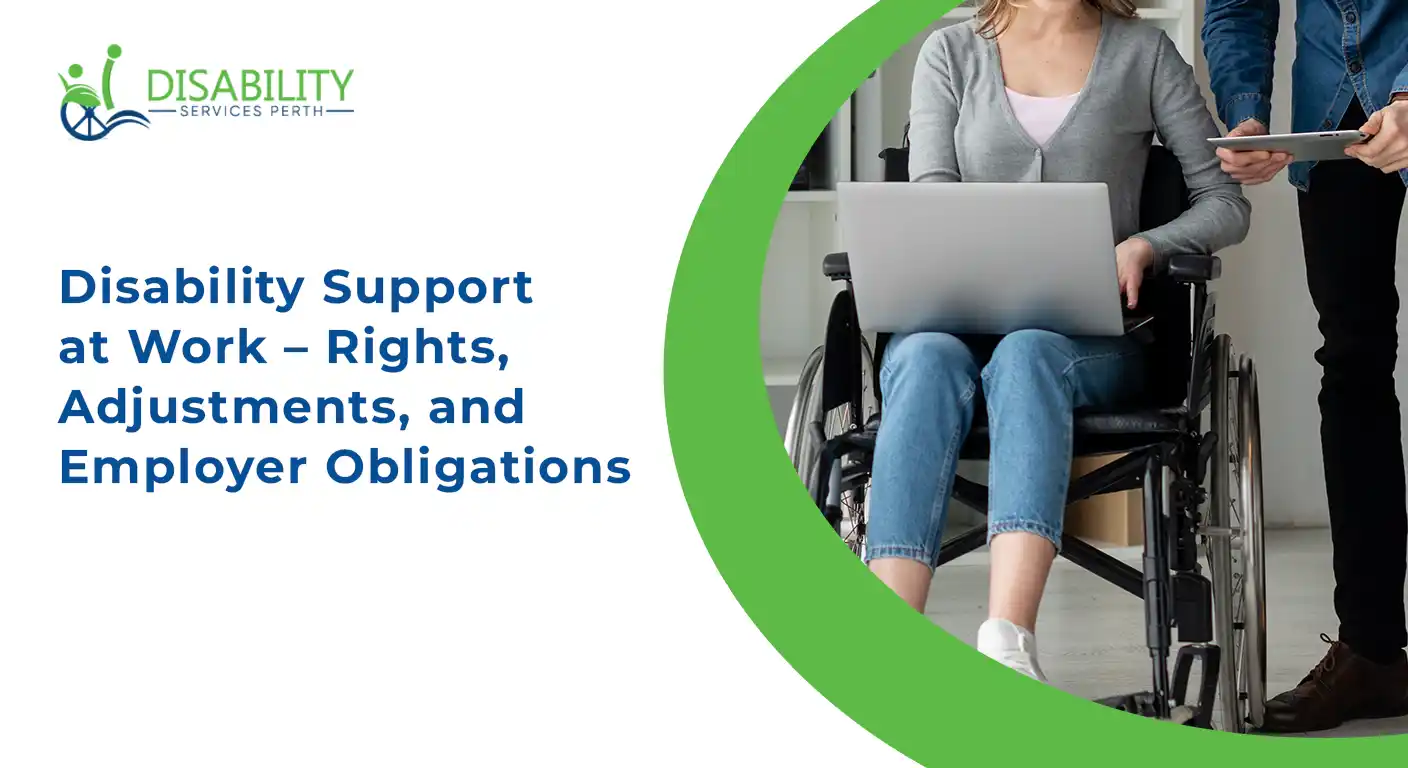Disability Support at Work – Rights, Adjustments, and Employer Obligations

Workplace Disability Support in Australia
Creating Inclusive and Accessible Work Environments
In today's modern world, workplaces play a vital role in creating an inclusive and accessible environment for people with disabilities. Supporting employees and job seekers with disabilities fulfils legal obligations and moral responsibilities.
Key Insight
Effective disability support at work enables people with disabilities to perform their roles efficiently while protecting their rights and fostering a supportive work culture. The Disability Discrimination Act 1992 encourages workplaces to make reasonable adjustments such as flexible hours, assistive technology, and modified duties.
Understanding Workplace Disability Rights in Australia
Workplace disability rights are protected under DDA, which prohibits unfair treatment, harassment, and discrimination based on disability.
Workplace Rights for People with Disabilities
- 1 Right to apply for jobs, training, and promotions
- 2 Day-to-day work responsibilities
- 3 Safe, respectful, and dignified work environment
- 4 Reasonable workplace adjustments
What the Disability Discrimination Act 1992 Says About Employment
The DDA 1992 makes it totally prohibited to engage in unfair practices against employees with disabilities.
Hiring & Promotion
Prohibits discrimination in training, promotion, and hiring processes
Reasonable Adjustments
Requires reasonable adjustments to promote fair, safe, and healthy environments
Equal Access
Ensures equal access to training and organizational facilities
Reasonable Adjustments at Workplace
Reasonable adjustments Australia are the changes made in every workplace to ensure the success of employees with disabilities in every role. These adjustments vary depending on individual needs and workplace nature.
Physical adjustments enhance workplace accessibility for individuals with impairments:
- • Accessible bathrooms and wheelchair ramps
- • Adapted computer equipment for better visibility
- • Modified workstation layouts
Create flexible working arrangements for disabled employees:
- ✓ Work from home options
- ✓ Flexible start and finish times
- ✓ Remote work access
- ✓ Part-time work arrangements
- → Modified duties and responsibilities
- → Additional training programs
- → Adjustments in working methods and patterns
Provide employees with new tools or modify existing ones to ensure safe and efficient task performance.
It is essential to address colleagues' attitudes and provide them with information about how reasonable adjustments contribute to the health, safety, and productivity of people with disabilities.
Employer Obligations to Provide Disability Support
Under the Disability Discrimination Act 1992, employers have specific obligations:
Mandatory Actions
- • Implement reasonable adjustments
- • Prevent harassment in the workplace
- • Train staff about disability respect and participation
Best Practices
- • Consult employees with disabilities for workplace changes
- • Avoid excluding and disadvantaging based on disability
Mutual Benefits
By meeting these obligations, both employees with disabilities and the company benefit through improved productivity and workplace efficiency.
Real-Life Examples of Disability Support at Work
There are numerous examples demonstrating how employment rights under DDA created a positive, inclusive, and supportive environment for individuals with disabilities.
Case Study: Kylie
Situation: A transgender woman with Autism faced harassment and discrimination at work, including disparaging remarks and denial of training.
Resolution: Complaint resolved through mutual separation agreement and monetary settlement.
Case Study: Bob
Situation: An experienced miner alleged disability discrimination after a mine ended his recruitment process due to spirometer readings, despite mild airflow limitation.
Resolution: Complaint resolved through monetary settlement following conciliation.
Case Study: Chantel
Situation: A mother with type 1 diabetes alleged disability and carer discrimination after her employer reduced bonuses due to sick and carer leave.
Resolution: Complaint resolved through monetary payment following conciliation.
How Employees Can Seek Support or Make a Complaint
Employees with disabilities experiencing unfair treatment or not receiving disability support at work can take the following steps:
-
Step 1Speak with your employerRaise your issues directly with management or HR first
-
Step 2Contact support servicesReach out to AHRC or Disability Employment Services for advice
-
Step 3File a formal complaintSubmit complaint with AHRC for conciliation or Federal Court
-
Step 4Seek legal helpConsult legal professionals if the issue is complex
Conclusion: Create an Inclusive Workplace Environment
The vitality of an inclusive working environment cannot be overstated. When employees with disabilities receive dedicated support from their employer, they can contribute to the company's productivity and success by performing their roles accurately.
By making reasonable adjustments to workplaces and employment criteria, organizations can ensure fair and equal treatment for all employees.
For more information on DDA and why it matters, visit our Disability Discrimination Act 1992 guideline.
